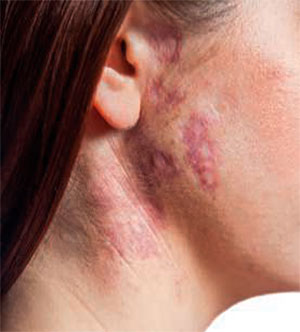Understanding Skin Stains in the Cosmetology Field: An Extensive Analysis
Skin stains, often characterized by irregular brown or wine-colored skin discolorations, are frequently encountered in the cosmetology practice. This comprehensive analysis seeks to explore the nature of skin stains, their causes, implications in the cosmetic industry, and how cosmetologists can effectively navigate the challenges they pose.

Skin Stains
What are Skin Stains?
Skin stains are areas of the skin that have changed color due to various factors. These discolorations can take the form of irregular brown or wine-colored patches and may exhibit circular or irregular shapes. It’s important to note that these changes in color are permanent and are caused by the presence of darker pigments.

Causes of Skin Stains
The causes of skin stains are as varied as their appearances. They may be present at birth, or develop as a person ages. Other factors contributing to skin stains include:
Diseases
Certain diseases, such as liver disease or Addison’s disease, can lead to skin hyperpigmentation, resulting in skin stains. These conditions often require medical intervention.
Post-Inflammatory Hyperpigmentation
This is a response to skin injury or inflammation such as acne, eczema, or psoriasis. It occurs when the skin produces more melanin in response to inflammation, resulting in patches of skin that are darker than the surrounding skin.
Disappearance of Skin Lesions
Stains may also appear after the disappearance of moles, freckles, and age spots. This can occur naturally or as a result of cosmetic or medical procedures.
Implications for Cosmetologists
Given their visibility, skin stains are often a cosmetic concern for individuals who have them. Cosmetologists, therefore, play a critical role in helping clients manage these skin changes.
Cosmetic Camouflage
Cosmetologists can provide guidance on how to use makeup to camouflage skin stains effectively, thus enhancing their clients’ confidence and self-esteem. This could involve teaching clients techniques for makeup application and recommending suitable products.
Referral to Healthcare Providers
While most skin stains are harmless, changes in size, shape, or color could signal an underlying health issue. Cosmetologists are often well-placed to identify these changes and should refer clients to a healthcare provider if such changes occur.
Client Education
Educating clients about the causes of skin stains can help them understand their skin better and take preventative measures where possible. For example, cosmetologists can advise on the importance of using sun protection to prevent skin discoloration caused by UV exposure.
Conclusion
As professionals who work closely with skin, cosmetologists have a crucial role to play in helping clients manage skin stains. By combining their expertise in cosmetic camouflage techniques with a commitment to ongoing skin health monitoring and client education, cosmetologists can provide comprehensive care that addresses both the aesthetic and health-related aspects of skin stains.






